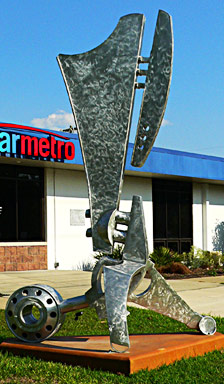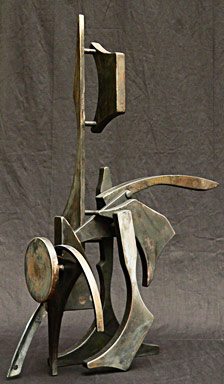One fabricator uses his metal shop skills to forge a new career path
Engrossed in the world of art from a young age, metal worker and sculptor Mark Dickson didn’t always think the art world could provide long-term job stability. By the time he was in his mid 20s, Dickson was managing landscape construction. Always intrigued by welding, he frequented a local welding shop. Soon he found out about welding courses at Sierra College in Rocklin, Calif. “I took a course in sculpture with an emphasis on welding and metal fabrication taught by an art professor and it changed my life,” he says.

The six-week course helped Dickson learn about different welding tools and techniques, including some helpful blacksmith training. After moving to Florida, Dickson attended Florida State University in Tallahassee where he studied metal fabrication and foundry processes. After an apprenticeship with a local expert, Dickson gained experience working with ornamental iron, forged aluminum, steel and advanced metal fabrication.
Dickson frequents local scrap yards in search of more affordable materials, including bronze, brass and steel. Dickson picks up industrial drops and derelict metal objects. “I perfected my techniques with MIG welding with a small Lincoln 135, which I used a lot in the early days at the studio, especially with steel,” he says. “I later bought a larger Miller 210 MIG welder for thicker material with a spool gun attachment for welding aluminum.” However, when working with aluminum, Dickson prefers GTAW. “I have a Miller Syncrowave 180 SD TIG stick welder,” he adds.
“TIG welders come in handy for aluminum, stainless steel, bronze, even brass,” he says, adding he’s currently creating a sculpture for Valdosta State University in Valdosta, Ga. He says TIG welding lets him marry steel and stainless or bronze and stainless together, allowing for a spatter-free, clean and nearly smokeless process.
Watching someone who is a professional TIG weld is to witness a beautiful process, Dickson says. “They lay down beautiful weld beads—whether for manufacturing, cars or motorcycles, it’s easy to identify these exceptional welds.”
The GTAW process eliminated the need for Dickson to do oxyacetylene welding. “I still braze certain things or weld once in a while for fun and I can’t do without my torch for cutting steel,” he says. “The oxyacetylene rig was the first tool I purchased.” Today, after accumulating a large number of welding, cutting and heating tips, he uses a rose bud tip for forging, bending and twisting.

Dickson often uses a Plasmacam 4 ft. cut table with a Thermal Dynamics plasma torch and software that allows him to sketch drawings and cut models using basic CAD software. “The CAD program allows me to do design work, scale and then cut the shapes out with great accuracy,” he says. “If I need to cut something from a larger or thicker sheet of metal, a friend has a big Torchmate plasma cut table.”
The City of Tallahassee’s public transit authority commissioned Dickson to create a sculpture for its administration facility. Using new sheet aluminum with a mill finish, Dickson incorporated discarded bus parts into the sculpture, including old panels of engine parts and bus rims.
His “Hammerhead Apparatus” and “Objects in Orbit” were created as part of an invitational exhibition in 2010 at the National High Magnetic Field Laboratory in Tallahassee, which houses some of the world’s most powerful magnets. Dickson used aluminum directly from the lab’s machine shop, which he then took to his studio and used in the final sculptures.

